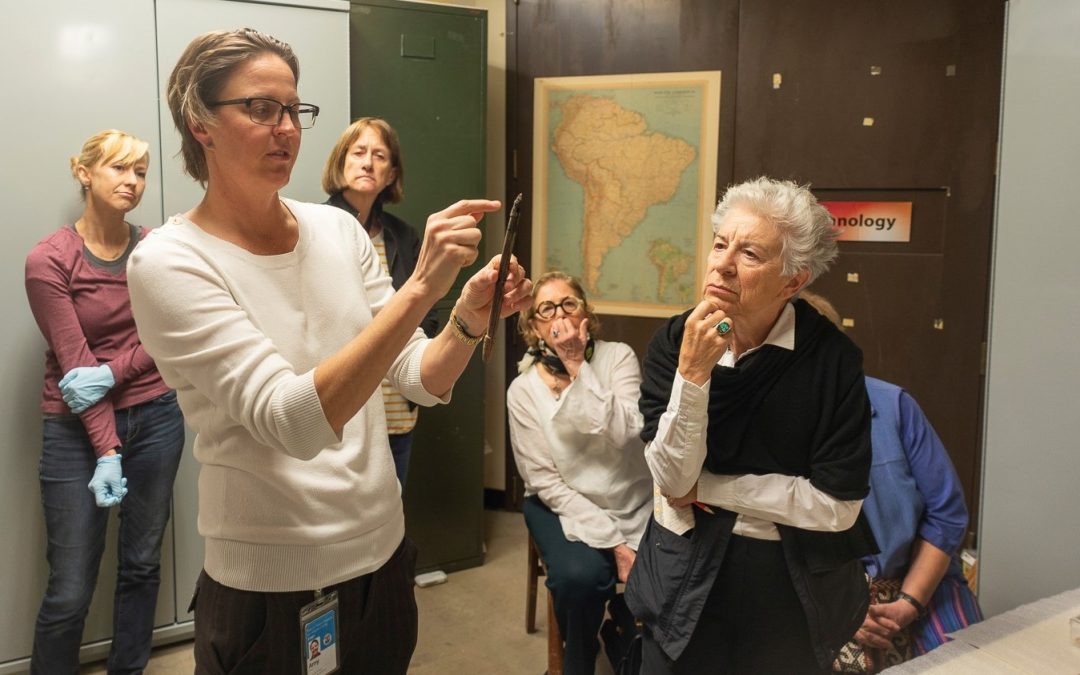Trip participants hear from Amy Gusick, associate curator of anthropology, during a behind-the-scenes tour of the collections at the Natural History Museum of Los Angeles County. Photo by Kitty Leaken.
“I love museums, and I love getting back behind the scenes,” says photographer and longtime SAR supporter Kitty Leaken. “Behind the scenes” is exactly what she got when she joined her fellow SAR members on the recent President’s Circle field trip New Directions: An Insider’s Look at Native American Collections in Los Angeles. With President Michael Brown, the group spent three days in Los Angeles touring the Autry Museum of the American West, its new resources center, the UCLA/Getty conservation lab, and other local museums and collections.
Begun in 2010, the state-of-the-art Resources Center of the Autry is a place where “students, scholars, artists, Native community members, and the broader public” can access the Autry’s extensive collections “to gain a deeper understanding of the rich history and cultural diversity of the American West.” “They took existing buildings and transformed them into this fantastic place,” says Kitty.
There’s a room where they meet with tribal people, and people can come in and examine items that they’re considering repatriating. There’s a changing room and then you can go over to this garden. It’s sort of a blessing garden or a prayer garden. It’s got a fountain and kind of a smudge area and greenery all around. It was really respectful, you know, to see this and the attention they’re paying to giving back.



From left to right: Members of the SAR President’s Circle and Board of Directors with instructors at the UCLA/Getty Master’s Program on the Conservation of Archaeological and Ethnographic Materials, Getty Conservation Institute, Getty Villa, photo by Michael Brown; Meg MacDonald from Travel Muse, our tour operator, in front of the Conservation Training Laboratory, Getty Villa, photo by Kitty Leaken; board member Ken Cole and Founders’ Society member Lauren Prescott on UCLA campus, photo by Kitty Leaken.
After the Autry, Kitty and the other members were taken to the Getty Villa, where they visited a laboratory of the Getty Conservation Institute, which “works internationally to advance conservation practice in the visual arts” and is, more specifically, “a creative force for the development of innovative approaches and model conservation strategies.”
“They had these students sitting there doing infrared photography and ultraviolet photography and many other kinds of photography that, of course, fascinated me,” says Kitty. “They’re learning how to conserve.” At the Getty, Kitty and the group met with Professor Ellen Pearlstein, who teaches students how to use SAR’s Guidelines for Collaboration, a resource recently developed at our Indian Arts Research Center by Native and non-Native museum professionals, cultural leaders, and artists. The guidelines—the first of their kind—offer principles for building successful partnerships between these groups.

Trip participants in conversation with students in the UCLA conservation program at the Getty Villa. Photo by Kitty Leaken.

SAR president Michael Brown examining objects in the collections area of the Natural History Museum of Los Angeles County. Photo by Kitty Leaken.
But the Getty wasn’t the only place where members learned about the guidelines. “That came up foremost at the Autry,” Kitty remembers, “because they really go by the SAR Guidelines for Collaboration. At the Fowler Museum and at the Natural History Museum, where we went, they are also addressing these issues.” Kitty had heard about the guidelines before joining the field trip, but getting to see them in action gave her greater insight into how they work and why they’re important:
Basically, it seemed to me that it’s a conversation. These guidelines aren’t set in stone, and they don’t have to be followed. But it sets up a basis for making people feel safe to come in and express tribal needs. I thought it was really cool that SAR was mentioned so frequently and referenced so often about this.
As Kitty and the others saw for themselves, SAR’s Guidelines for Collaboration are being used to advance conservation efforts in places around the country and to teach the next generation of museum professionals—the people who will be shaping practices and shifting paradigms in museums all over the world.
Not only do the members who travel with SAR get “total behind-the-scenes access,” as Kitty put it, to institutions that are advancing work in conservation on technological, ethical, and collaborative levels, they have fun together, too.
It was a great group. I think everybody got along really well. People were intelligent and inquiring, really sort of raising the bar, I think, in terms of the lectures and the issues that were being discussed. I thought it was great.

Taking a rest in the galleries at the Fowler Museum at UCLA. Photo by Kitty Leaken.
SAR is “a living place,” says Kitty. It brings “a lot of things together” to offer access to once-in-a-lifetime kinds of experiences. Members have visited artists’ studios on the Hopi Mesas, historic trading posts of the Southwest, and a groundbreaking exhibit opening at the Minneapolis Institute of Art. Join us on our next trip for a behind-the-scenes experience you won’t soon forget. “I’ll go anywhere,” says Kitty, “put me on a bus!” We’ll save you a seat.
